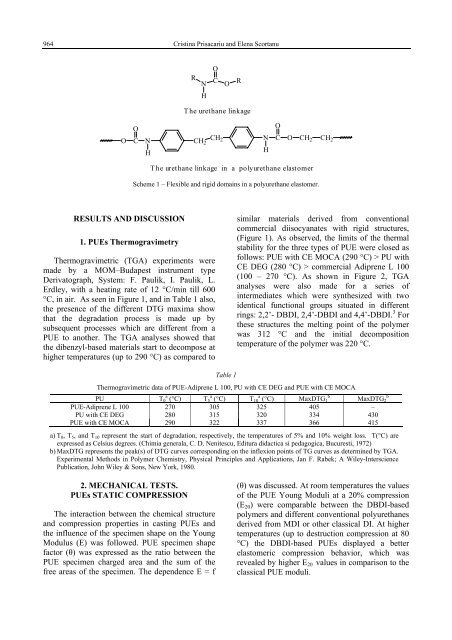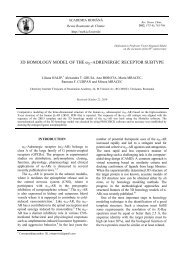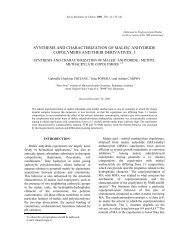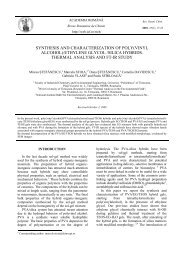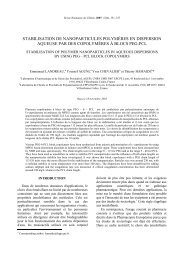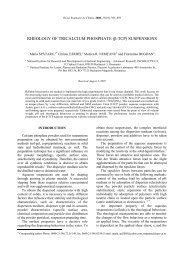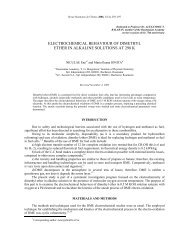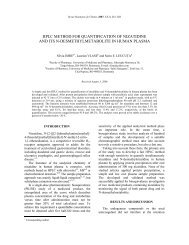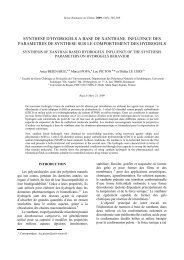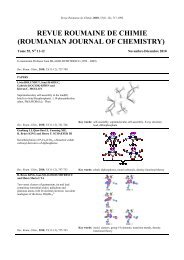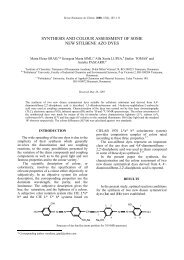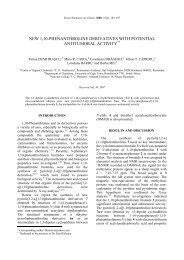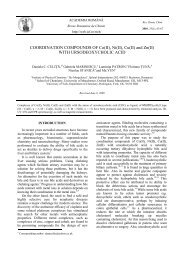the thermal behaviour of selected crosslinked polyurethanes as ...
the thermal behaviour of selected crosslinked polyurethanes as ...
the thermal behaviour of selected crosslinked polyurethanes as ...
- No tags were found...
Create successful ePaper yourself
Turn your PDF publications into a flip-book with our unique Google optimized e-Paper software.
964 Cristina Prisacariu and Elena ScortanuORNHCORThe urethane linkageOOCON CHCH 2 2N CHHOCH 2 CH 2The urethane linkage in a polyurethane el<strong>as</strong>tomerScheme 1 – Flexible and rigid domains in a polyurethane el<strong>as</strong>tomer.RESULTS AND DISCUSSION1. PUEs ThermogravimetryThermogravimetric (TGA) experiments weremade by a MOM–Budapest instrument typeDerivatograph, System: F. Paulik, I. Paulik, L.Erdley, with a heating rate <strong>of</strong> 12 °C/min till 600°C, in air. As seen in Figure 1, and in Table 1 also,<strong>the</strong> presence <strong>of</strong> <strong>the</strong> different DTG maxima showthat <strong>the</strong> degradation process is made up bysubsequent processes which are different from aPUE to ano<strong>the</strong>r. The TGA analyses showed that<strong>the</strong> dibenzyl-b<strong>as</strong>ed materials start to decompose athigher temperatures (up to 290 °C) <strong>as</strong> compared tosimilar materials derived from conventionalcommercial diisocyanates with rigid structures,(Figure 1). As observed, <strong>the</strong> limits <strong>of</strong> <strong>the</strong> <strong>the</strong>rmalstability for <strong>the</strong> three types <strong>of</strong> PUE were closed <strong>as</strong>follows: PUE with CE MOCA (290 °C) > PU withCE DEG (280 °C) > commercial Adiprene L 100(100 – 270 °C). As shown in Figure 2, TGAanalyses were also made for a series <strong>of</strong>intermediates which were syn<strong>the</strong>sized with twoidentical functional groups situated in differentrings: 2,2’- DBDI, 2,4’-DBDI and 4,4’-DBDI. 3 For<strong>the</strong>se structures <strong>the</strong> melting point <strong>of</strong> <strong>the</strong> polymerw<strong>as</strong> 312 °C and <strong>the</strong> initial decompositiontemperature <strong>of</strong> <strong>the</strong> polymer w<strong>as</strong> 220 °C.Table 1Thermogravimetric data <strong>of</strong> PUE-Adiprene L 100, PU with CE DEG and PUE with CE MOCAPU T a 0 (°C) T a 5 (°C) T a 10 (°C)bMaxDTG 1bMaxDTG 2PUE-Adiprene L 100 270 305 325 405 –PU with CE DEG 280 315 320 334 430PUE with CE MOCA 290 322 337 366 415a) T 0 , T 5 , and T 10 represent <strong>the</strong> start <strong>of</strong> degradation, respectively, <strong>the</strong> temperatures <strong>of</strong> 5% and 10% weight loss. T(°C) areexpressed <strong>as</strong> Celsius degrees. (Chimia generala, C. D. Nenitescu, Editura didactica si pedagogica, Bucuresti, 1972)b) MaxDTG represents <strong>the</strong> peak(s) <strong>of</strong> DTG curves corresponding on <strong>the</strong> inflexion points <strong>of</strong> TG curves <strong>as</strong> determined by TGA.Experimental Methods in Polymer Chemistry, Physical Principles and Applications, Jan F. Rabek; A Wiley-IntersciencePublication, John Wiley & Sons, New York, 1980.2. MECHANICAL TESTS.PUEs STATIC COMPRESSIONThe interaction between <strong>the</strong> chemical structureand compression properties in c<strong>as</strong>ting PUEs and<strong>the</strong> influence <strong>of</strong> <strong>the</strong> specimen shape on <strong>the</strong> YoungModulus (E) w<strong>as</strong> followed. PUE specimen shapefactor (θ) w<strong>as</strong> expressed <strong>as</strong> <strong>the</strong> ratio between <strong>the</strong>PUE specimen charged area and <strong>the</strong> sum <strong>of</strong> <strong>the</strong>free are<strong>as</strong> <strong>of</strong> <strong>the</strong> specimen. The dependence E = f(θ) w<strong>as</strong> discussed. At room temperatures <strong>the</strong> values<strong>of</strong> <strong>the</strong> PUE Young Moduli at a 20% compression(E 20 ) were comparable between <strong>the</strong> DBDI-b<strong>as</strong>edpolymers and different conventional <strong>polyurethanes</strong>derived from MDI or o<strong>the</strong>r cl<strong>as</strong>sical DI. At highertemperatures (up to destruction compression at 80°C) <strong>the</strong> DBDI-b<strong>as</strong>ed PUEs displayed a betterel<strong>as</strong>tomeric compression behavior, which w<strong>as</strong>revealed by higher E 20 values in comparison to <strong>the</strong>cl<strong>as</strong>sical PUE moduli.


